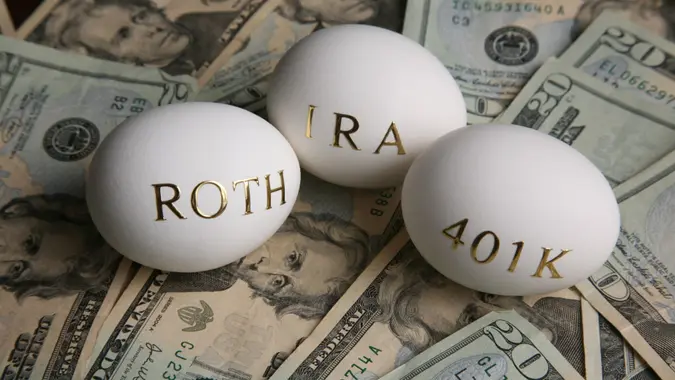Extreme Frugality in Retirement: 15 Practical Ways to Cut Costs

Commitment to Our Readers
GOBankingRates' editorial team is committed to bringing you unbiased reviews and information. We use data-driven methodologies to evaluate financial products and services - our reviews and ratings are not influenced by advertisers. You can read more about our editorial guidelines and our products and services review methodology.

20 Years
Helping You Live Richer

Reviewed
by Experts

Trusted by
Millions of Readers
Retirement gives you more time to enjoy life, but often less income to do it with. That’s where extreme frugality comes in. By cutting unnecessary expenses, living intentionally and finding creative ways to save, retirees can stretch their savings for decades without sacrificing happiness.
The good news? Extreme frugality doesn’t mean giving up joy. It means focusing on what truly matters while trimming the rest. This guide covers 15 practical ways to live well on less, plus tips, examples and insights from research.
What Is Extreme Frugality?
Extreme frugality is a lifestyle choice that focuses on reducing expenses to a minimum while still meeting essential needs. Unlike casual budgeting, it requires aggressive, intentional cuts but the payoff is long-term security.
For retirees, that might mean:
- Downsizing to a smaller home.
- Cooking meals at home instead of dining out.
- Using public transportation instead of maintaining two cars.
- Prioritizing free or low-cost hobbies.
It’s about trade-offs: choosing financial peace over luxury. With Americans living longer than ever — the average 65-year-old today is expected to live another 19 to 21 years, according to the U.S. Social Security Administration — it’s crucial to make every dollar count. Add in rising healthcare costs and inflation, and it’s easy to see why more retirees are embracing frugal living.
Why Retirees Choose Extreme Frugal Living
- Healthcare is expensive. Fidelity estimates a 65-year-old couple will need about $315,000 for healthcare in retirement.
- Inflation shrinks buying power. According to the Bureau of Labor Statistics, prices rose 9.1% in 2022, the highest in four decades. Even moderate inflation can erode fixed incomes.
- Savings often fall short. The Federal Reserve reports that 27% of non-retired adults have no retirement savings at all, while Vanguard data shows the median 401(k) balance for those 65 or older is just $87,725.
- Peace of mind matters. Research from the Employee Benefit Research Institute found retirees with lower financial stress report higher overall life satisfaction, regardless of income.
Housing — Reduce Your Biggest Expense
Housing is usually a retiree’s largest cost, so trimming here offers the biggest impact.
- Downsize: Moving into a smaller house or condo reduces utilities, taxes and upkeep.
- Relocate: Consider moving to a lower-cost state or abroad. AARP lists Portugal, Mexico and Costa Rica as popular, affordable destinations.
- Rent out space: Spare bedrooms, garages or basements can generate extra income.
- Pay off your mortgage early: Eliminating this monthly expense frees thousands annually.
Example: A couple who sold their $400,000 home and bought a $250,000 condo freed up equity while cutting monthly expenses by nearly $1,000.
Food — Eat Well on a Budget
Food is another big area for savings, and you don’t have to compromise on nutrition.
- Cook at home. Eating out is typically 3 to 4x more expensive.
- Meal plan to reduce food waste; the USDA estimates households waste about $1,500 of food per year.
- Buy in bulk or use discount stores like Aldi.
- Grow your own vegetables. Even a small garden can save hundreds annually.
Transportation — Cut Car and Travel Costs
Cars eat into retirement budgets through gas, insurance and repairs.
- Sell extra vehicles and use one car.
- Use public transit or senior ride programs.
- Walk or bike for short trips (good for health, too).
- Switch to a used, fuel-efficient vehicle with lower insurance rates.
Healthcare — Plan Ahead to Save
Medical costs can wreck retirement budgets if you’re not careful.
- Compare Medicare plans annually. Switching can save hundreds per year (KFF).
- Opt for generic prescriptions and use discount programs like GoodRx.
- Stay on top of preventative care; the CDC notes that preventive services lower the risk of costly health issues later.
- Use community clinics or senior health programs for reduced fees.
Utilities and Monthly Bills — Find Hidden Savings
Everyday bills add up, but most retirees can cut them with a little effort.
- Cancel unused subscriptions and streaming services.
- Install energy-efficient appliances and LED bulbs; the Department of Energy says LEDs use 90% less energy.
- Lower thermostat settings by a few degrees to trim heating and cooling costs.
- Ask about senior discounts on internet and phone plans.
Entertainment and Lifestyle — Fun Without the Price Tag
Retirement should be fun, and you don’t need to spend big to enjoy life.
- Attend free concerts, festivals, and library events.
- Volunteer to get free access to museums or theaters.
- Join hobby swaps like book clubs, craft circles or gardening groups.
- Keep gifts simple with handmade items or low-cost, thoughtful options.
Extra Income Ideas to Support Frugal Living
Extreme frugality pairs well with side income.
- Rent out part of your home or storage space.
- Sell unwanted items online or at yard sales.
- Try part-time work like tutoring, pet sitting or freelancing.
- Use cash-back cards and loyalty programs to stretch spending.
Real-life note: According to Pew Research, 20% of adults 65 or older are still working, many part-time, to support retirement budgets.
Sample Frugal Budget in Retirement
Here’s how an extreme frugality budget compares to average retiree spending:
| Category | Average Monthly Cost | Extreme Frugality Cost |
|---|---|---|
| Housing | $1,200 | $800 (downsized) |
| Food & groceries | $600 | $350 (meal planning, bulk buying) |
| Transportation | $500 | $250 (one car, biking) |
| Healthcare | $700 | $500 (generic meds, Medicare shopping) |
| Utilities & bills | $300 | $200 (energy savings) |
| Entertainment & misc. | $400 | $150 (free activities) |
| Total | $3,700 | $2,250 |
That’s a savings of $1,450 per month, nearly $17,000 per year.
The Psychological Benefits of Frugality
Living with less isn’t just about money; it can improve well-being.
- Less stress. Fewer bills mean fewer financial worries.
- More gratitude. Focusing on essentials builds appreciation for what you have.
- Stronger community. Many frugal activities, like volunteering or gardening, create social connections.
Harvard’s Study of Adult Development, the longest-running study on happiness, shows that strong relationships are the key to fulfillment, not spending. Frugality can free resources to invest time and energy into those connections.
Final Take to GO
Extreme frugality in retirement isn’t about living with nothing; it’s about living with purpose. By cutting housing, food, healthcare and lifestyle costs, retirees can free up thousands each year, reduce stress and still enjoy meaningful activities.
The trick is balance: start with small changes, build momentum and reassess regularly. Over time, frugality becomes less about sacrifice and more about freedom.
Want to learn more? Check out our guides on how to live well on Social Security alone and smart ways to stretch your retirement income.
FAQs
Here are the answers to some of the most frequently asked questions about extreme frugality in retirement and how it works:- What are the easiest expenses to cut first in retirement?
- Housing, utilities and food usually give the biggest savings.
- Can extreme frugality still allow for travel or hobbies?
- Yes -- focus on off-season travel, low-cost hobbies and free community activities.
- How do I stay motivated living on a strict budget?
- Set small goals, track your wins and remind yourself of the financial security you’re building.
- Is extreme frugality necessary if I have some savings?
- Not always, but it helps protect against inflation, healthcare shocks and longevity risk.
- What’s the biggest mistake retirees make when cutting costs?
- Cutting too deeply into essentials like nutrition or healthcare. Focus on trimming wants, not needs.
Data is accurate as of Sept. 3, 2025, and is subject to change.
Our in-house research team and on-site financial experts work together to create content that’s accurate, impartial, and up to date. We fact-check every single statistic, quote and fact using trusted primary resources to make sure the information we provide is correct. You can learn more about GOBankingRates’ processes and standards in our editorial policy.
- Employee Benefit Research Institute "EXPECTATIONS ABOUT RETIREMENT FACTSHEET"
- U.S. Department of Social Security "Life Expectancy for Social Security"
- Fidelity "How Much Will Healthcare Cost You in Retirement?"
- U.S. Bureau of Labor Statistics "Consumer prices up 9.1 percent over the year ended June 2022, largest increase in 40 years"
- The U.S. Federal Reserve "Survey Says: 27% of Boomers Have Nothing Saved for Retirement"
- Vanguard "How America Saves 2025"
- U.S. Department of Agriculture "Food Loss and Waste"
- CDC "Are You Up to Date on Your Preventive Care?"
- U.S. Department of Energy "Lighting Choices to Save You Money"
- The Pew Research Center "The growth of the older workforce"
- The Harvard Gazette "Good genes are nice, but joy is better"
 Written by
Written by  Edited by
Edited by 

























